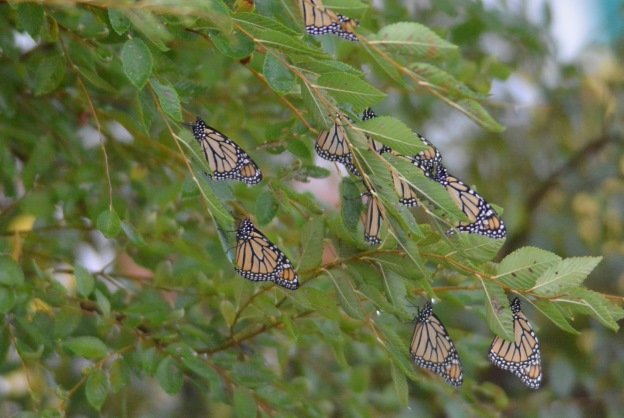Wild Pantex - Thinking Milkweed
Article by Jim Ray, Pantex Wildlife Biologist/Scientist
This August and September time frame has long been thought of as a special time by Pantex Agronomist, Monty Schoenhals, and myself. The reason is two-fold; these months are the peak time period when monarch butterflies are drifting through the region and when an abundance of milkweeds are in bloom and hosting an impressive number of monarch caterpillars. We have our own interest in the monarch’s use of this 18,000-acre federal facility and the Texas Panhandle as a whole, but we also now have justification to study and protect the monarch and the habitats that it and other pollinators so desperately need for survival. The White House Pollinator Initiative was announced in early 2014, and we have busied ourselves with mapping colonies of milkweed, documenting caterpillars, proposing research, and, although unsuccessful so far, we are applying for grants.

Migrating monarch butterflies cluster on elm trees after resting through the night at Pantex.
Our current philosophies are to manage for and protect wildflowers through sound range management and adjusted mowing practices, have a strong focus on milkweeds, and monitor monarch production on the site. We are excited that we find an abundance of milkweeds including six species, 1) antelope-horns (Asclepias asperula), 2) broad-leaf (A. latafolia), 3) Engelmann’s (A. engelmanniana), 4) horsetail (A. subverticillata), 5) plains (A. pumila), and 6) whorled (A. verticillata) milkweed! Go out and locate a colony of horsetail, plains or whorled milkweed right now, and you will see monarchs visiting for nectar and possibly laying eggs.
Time will only tell if the monarch butterfly can rebound from historically low populations, but we can certainly do our part here at Pantex and even in backyards across this nation. Study up on native plants that are important to our native pollinators. Protect the ones in our landscapes and plant them on your properties. Now is a particularly good time to protect and plant milkweeds. See which ones should be in your area and search for seed for those species. At a minimum, migrating monarchs will need nectar sources, and many will lay eggs on milkweeds in order to produce that next generation that has a better chance of reaching points south on their journey to their wintering sites in Mexico. We here at Pantex hope that we are able to contribute to that great cause.

A monarch caterpillar feeding on horsetail milkweed at the Pantex Plant in 2015
